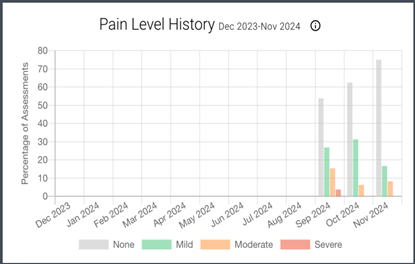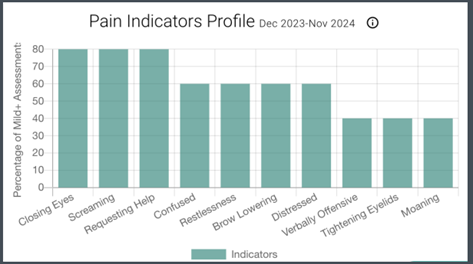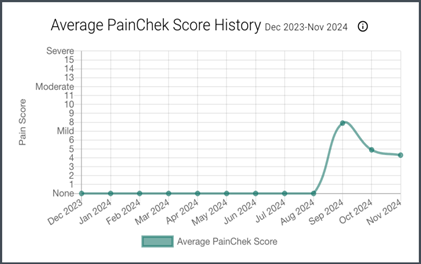18 December 2025
Youth Parliament members hope to ‘go viral’ to help the NHS this…
A group of young people from the Central Bedfordshire Youth Parliament could be heading for worldwide social media fame after creating a series of video…


Home >> news >> PainChek™ case studies
Installed on a care home’s mobile phone or tablet device, PainChek™ uses artificial intelligence (AI) to assess pain levels before quantifying a pain score which carers can use to inform their decision about appropriate support. This is particularly useful for residents who are unable to express themselves verbally, due to illness or disability.
The following case studies are all recent examples from local care homes. Names have been changed so that the residents remain anonymous.
Find out more about PainChek™.
Anton, a care home resident, has advanced dementia and receives end of life care. He was taking regular paracetamol, ibuprofen gel and antipsychotic medication.
The care home staff noticed that Anton often seemed distressed, particularly while they were providing personal care to him.
In July 2024, Anton tried to bite a member of staff and bit himself instead. To understand how and why this happened, the staff carried out PainChek™ assessments which identified Moderate pain (a score of 10). The decision was made to send Anton to hospital.
No changes were made to Anton’s medication after the hospital visit, but the care home team were concerned that he was still visibly distressed. They continued to monitor him with PainChek™, and passed on the results to Anton’s GP, who prescribed a pain patch in August. This has helped to reduce Anton’s distress and level of pain (to a score of 2).
While PainChek™ assessments show that Anton’s pain is getting slightly worse again (climbing to a score of 5 in November 2024), this data will enable the care home team to continue having data-led discussions with his GP and mental health teams, so they can do as much as possible to keep Anton comfortable.

Since having a stroke, Bea hasn’t been able to tell others if she is in pain. The staff at her care home noticed that she didn’t seem hungry, and suspected this might be due to being in pain. In September 2024, they began taking regular PainChek™ assessments to build a picture of Bea’s pain levels.
The assessments identified both Moderate and Severe levels of pain (shown in yellow and red on the figure below). The care home team shared this data with Bea’s GP, who then prescribed paracetamol to be taken regularly, and codeine to be taken as required.
Bea’s pain has since reduced (more of her pain assessments show no pain, and there have been no further assessments showing severe pain). She is now more comfortable and has got her appetite back.
Sharing PainChek™ data with healthcare professionals enables collaborative discussions about medication adjustments. Given Bea’s inability to articulate pain, PainChek™ has been a vital tool for her carers to regularly monitor her pain levels.

Charlie has dementia, which has affected his ability to explain whether he is in pain and has changed his behaviour. Charlie had previously complained of pain in his right knee and was prescribed diclofenac gel.
In September 2024, the care team in Charlie’s residential home used PainChek™ to identify that he was in Mild pain (a score of 5). The assessments also helped them to understand how Charlie expresses his discomfort – such as closing his eyes, screaming, and asking for help.
Once Charlie’s GP received this data from the care home team, a pain patch was prescribed. The care home team continue to monitor Charlie’s pain, and the data shows a reduction in his pain level (down to zero in November 2024).
Due to her dementia, Debbie is unable to express if she is in pain. She has suffered from very swollen and red legs for a while, but was not on any pain relief – even for dressing changes.

The team at Debbie’s care home suspected that she was sometimes in pain, but were unsure. Through PainChek™ assessments, Debbie’s carers identified Mild pain (a score of 8), which gave them the evidence and confidence to ask her GP to consider a pain relief prescription.
Following a discussion with the GP and using the PainChek™ data as evidence, Debbie was prescribed a pain patch in September 2024. Debbie’s care home team continue to monitor her pain, and the data shows it has reduced (to a score of 4 in November 2024).
18 December 2025
Youth Parliament members hope to ‘go viral’ to help the NHS this…
A group of young people from the Central Bedfordshire Youth Parliament could be heading for worldwide social media fame after creating a series of video…
18 December 2025
Help us get loved ones home for Christmas
Local hospitals across Bedfordshire, Luton and Milton Keynes are calling on family and friends to help get their loved ones home before the holiday season. …
16 December 2025
Patients urged to use NHS services wisely ahead of planned doctors’ strike…
Patients in Bedfordshire, Luton and Milton Keynes have been asked to help the local NHS to preserve care for those who most need it, ahead of a national strike by…
1 December 2025
Digital records support care providers to work more efficiently and deliver more…
A project to support care providers in Bedfordshire, Luton and Milton Keynes to adopt digital records has achieved all its planned objectives and demonstrated an impressive return on investment. The…
14 November 2025
Local NHS preparing for strike action
The doctors’ union the British Medical Association has announced that resident doctors across the country will be taking industrial action for five days, after national pay negotiations failed to reach…
14 November 2025
New support for cancer patients across Bedfordshire and Milton Keynes launched
Bedfordshire, Luton and Milton Keynes Integrated Care Board (BLMK ICB) has launched a new suite of informative videos designed to support patients, families and carers throughout their cancer care journey.…